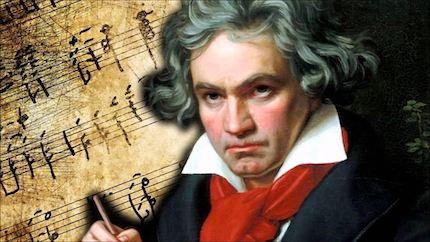
Ludwig van Beethoven (1770-1827, age 57). One of the most legendary and transformative figures in the history of music. A true revolutionary, he bridged the Classical and Romantic eras and redefined what music could express.
Quick Bio
- Born: December 17, 1770 (baptized), Bonn, Germany
- Died: March 26, 1827, Vienna, Austria
- Occupation: Composer and pianist
- Era: Classical transitioning into Romantic
- Signature: Deep emotion, bold structure, and heroic energy
Importance
- Beethoven pushed classical forms to their limits, infusing them with intensity, struggle, and personal emotion.
- He composed some of the most enduring symphonies, sonatas, and concertos in history.
- Perhaps most astonishingly: he did much of this while losing his hearing — by his later years, he was completely deaf.
Major Works
Symphonies (he wrote 9 total)
- Symphony No. 5 (“da-da-da-DAA”) – The most famous four notes in Western music.
- Symphony No. 6 (“Pastoral”) – A nature-inspired, peaceful work.
- Symphony No. 9 – With the “Ode to Joy” finale — revolutionary for using chorus and soloists in a symphony.
Piano Sonatas
- Moonlight Sonata
- Pathetique
- Appassionata These are deeply expressive and technically complex — touchstones for every serious pianist.
Other Highlights
- Fidelio – His only opera, about justice and freedom
- Missa Solemnis – Monumental sacred music
- String Quartets – Especially his late quartets, which were way ahead of their time (and baffled early audiences)
The Man Behind the Music
- Deafness: Started in his late 20s. Despite this, he continued composing, often “hearing” the music in his mind.
- Personality: Brilliant but fiery. Known for being reclusive, eccentric, and uncompromising.
- Legacy: The ultimate “tortured genius” archetype — and yet, his music is filled with life, hope, and struggle.
Impact
- Transformed music from entertainment to deep emotional expression.
- Influenced Brahms, Wagner, Mahler, Liszt, Schumann, and virtually every composer after him.
- Ode to Joy is now the anthem of the European Union — a symbol of unity